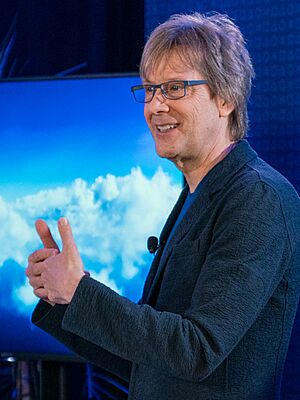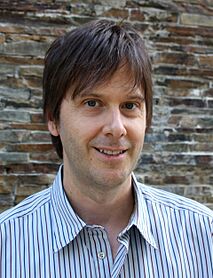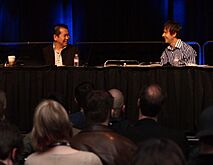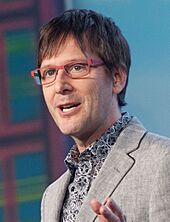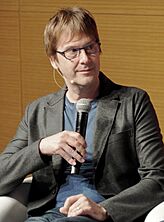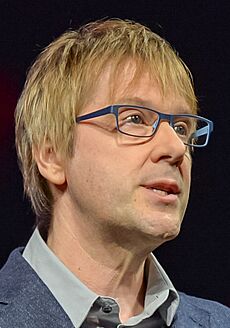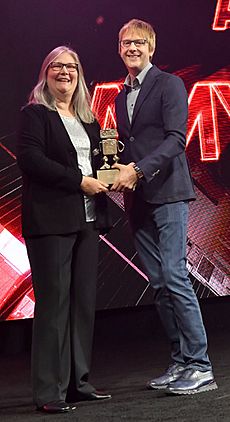Mark Cerny facts for kids
Mark Evan Cerny is an American video game designer, programmer, and producer. He was born in 1964 or 1965. He is well-known for his work on many popular video games. He also helped design the hardware for several PlayStation consoles.
Mark grew up in the San Francisco Bay Area. He went to UC Berkeley for a short time. Then, he left college to start his career in video games. Early in his career, he worked at companies like Atari and Sega. He also worked at Crystal Dynamics and Universal Interactive Studios. In 1998, he started his own company, Cerny Games. He became an independent consultant.
While at Sega, he helped create Sega Technical Institute. He worked on games like Sonic the Hedgehog 2 (1992). Mark often works with Sony Interactive Entertainment. He was the main designer for the PlayStation Vita, PS4, and PS5. He also advised game studios like Naughty Dog and Insomniac Games. These studios made famous games like Crash Bandicoot and Spyro the Dragon.
Mark Cerny designed the arcade game Marble Madness. He also created the Knack game series. In 2004, he received a Lifetime Achievement Award. This award was from the International Game Developers Association. In 2010, he was added to the Academy of Interactive Arts & Sciences Hall of Fame.
Contents
Mark Cerny's Early Career
Starting Out in Games (1982–1996)
Mark Evan Cerny was born in 1964 or 1965. He loved computer programming and arcade games when he was young. In 1982, at age 17, he got an amazing chance. He was invited to join Atari, a famous game company. He left college to take this opportunity.
Mark started at Atari on January 18, 1982. In those early days, game teams were small. Each person did many different jobs. He worked with game legends like Ed Logg on Millipede. He also worked with Owen Rubin on Major Havoc. Mark said working at Atari was an unforgettable experience. He learned from creative and passionate people.
Designing Marble Madness
Mark's first big success was the arcade game Marble Madness. He was only 18 years old. He worked as the designer and a programmer for the game. Around 1985, he also became interested in how game consoles are built. He thought designing hardware was simpler back then.
By the late 1980s, Mark joined Sega. He first worked in Japan. Then, in 1991, he came back to the United States. He helped start the Sega Technical Institute. There, he worked on games for the Master System and Genesis. One of his most famous projects was Sonic the Hedgehog 2.
Moving to Crystal Dynamics and Universal
In 1992, Mark left Sega to join Crystal Dynamics. This was a new game studio. He worked on games for the 3DO console. These included Crash 'n Burn (1993) and Total Eclipse (1994). Mark played a key role in helping Crystal Dynamics. They became the first American company to get a PlayStation development kit. He went to Japan to make this deal with Shuhei Yoshida from Sony.
Even though the PlayStation kit arrived in 1994, Mark left Crystal Dynamics. He went to lead a new game division for Universal Pictures.
Partnering with Sony
From 1994 to 1998, Mark worked at Universal Interactive Studios. This was a new video game part of Universal. Mark was a vice president and later its president. He had a lot of freedom there. He said Universal didn't know much about games. This meant he had money to spend and no one watching over him.
Under Mark's leadership, Universal Interactive Studios hired two small, new game studios. These were Naughty Dog (three people) and Insomniac Games (two people). Mark used his connections at Sony to help them. Naughty Dog made Way of the Warrior. Then, Mark helped them with Crash Bandicoot. Sony decided to publish Crash Bandicoot in 1996.
Insomniac Games finished their first game, Disruptor. Mark then helped them get ready for their next game, Spyro the Dragon. Sony also published Spyro the Dragon in 1998. When their contracts with Universal ended, both Naughty Dog and Insomniac signed with Sony. Mark stayed in close touch with both teams.
In 1998, Universal had money problems. They stopped hiring new people for the game group. Mark decided to leave Universal. He became a consultant with his own company, Cerny Games. This allowed him to keep working with Naughty Dog, Insomniac, and Sony.
Helping with PlayStation 2 and 3
Around 1999, Sony was making the PlayStation 2. Shuhei Yoshida, now a product development executive, asked Mark for help. He wanted Mark to develop a graphics engine for the new console. Mark agreed. He worked in Japan for three months. He was the first American to work on the PlayStation 2.
After the engine was done, Mark helped Naughty Dog and Insomniac. He assisted them with their first PlayStation 2 games. These were Jak & Daxter: The Precursor Legacy and Ratchet & Clank. He also helped with many sequels in both series. During this time, Mark created his "Method" approach for game development. This method is now a common practice in the game industry.
Mark continued to advise Sony. In 2003, Yoshida was promoted. Planning for Sony's next console, the PlayStation 3, had begun. Yoshida asked Mark to help make the new console work with older games. This would make it easier and cheaper for developers. Mark worked with Sony and Naughty Dog to form the Initiative for a Common Engine (ICE) Team. This team worked with Sony's hardware developers in Japan. The PlayStation 3's main hardware, the Cell, was difficult to work with. However, some of the ICE Team's goals were still achieved. Mark also helped Naughty Dog and Insomniac with their first PlayStation 3 games. These included Uncharted: Drake's Fortune and Resistance: Fall of Man. He also helped with other Sony games like God of War III and Killzone 3.
PlayStation Lead Architect
Around 2007, Sony was thinking about the next PlayStation after the PS3. The PS3 had not sold as well as Sony hoped. Mark researched the history of computer processors. He then suggested a plan to Yoshida. He wanted to be the lead designer for the next PlayStation. He wanted to make sure it was easy for game developers to use. Yoshida agreed. This helped convince Sony's leaders to let Mark, as a consultant, lead the PlayStation 4's design.
Mark's approach to the PlayStation 4's design was very important. It helped the console sell over 100 million units by 2019. This made it one of the best-selling PlayStations ever. Besides hardware, Mark also led the creation of one of the PlayStation 4's launch games, Knack, and its sequel, Knack 2.
Mark continued as the lead designer for Sony's future consoles. This included the handheld PlayStation Vita and the PlayStation 5. Mark says being a consultant gives him more freedom. He can work with many different groups at Sony. This helps him improve the PlayStation design. He also continued to advise on game design for several Sony games. These include The Last Guardian, Marvel's Spider-Man, and Death Stranding.
Since about 2009, Mark has followed a two-year cycle. He visits most of Sony's game developers. He asks them what problems they have with the current hardware. He also asks what they want in future hardware. These visits help improve consoles or software. They also help decide the direction for the next generation of consoles.
The Method Process
Mark Cerny created the "Method" process in 2002. He developed it while working with Naughty Dog, Insomniac, and other Sony studios. Mark noticed that making a game has two very different parts: pre-production and production. He realized you can't put a strict timeline on the creative part.
He suggested that the pre-production stage should be very open. Game creators should be free to explore if a game idea will work. The goal of this stage is to create a "publishable first playable" version of the game. This version helps decide if the game is worth making. It doesn't need to be finished. But it should be good enough for people to play and test. If players aren't excited by this early version, the game idea should be stopped. This saves a lot of effort.
Once the decision is made to go forward, Mark's Method suggests using regular milestones. These are checkpoints to keep the project on track.
Mark Cerny's Personal Life
While working for Sega in Japan in the 1980s and 1990s, Mark learned Japanese. He met his wife in Japan. She helped him start Cerny Games. She still manages the company today.
Awards and Recognition
The International Game Developers Association gave Mark Cerny the Lifetime Achievement Award in 2004. This was at the Game Developers Choice Awards. The IGDA said Mark is rare because he has a great vision for games. He also helps all the different parts of game creation work together. They called him a "master collaborator." His games Crash Bandicoot and Spyro the Dragon have sold over 30 million copies combined.
In 2010, Mark Cerny was added to the Academy of Interactive Arts & Sciences Hall of Fame. Joseph Olin, who was the president of the AIAS, said Mark Cerny is like a modern-day Leonardo Da Vinci. He said Mark does not just focus on one part of game creation. He is a talented game designer, producer, programmer, and technology expert. He also speaks Japanese and knows a lot about the Japanese game market.
Games Mark Cerny Worked On
| Year | Game title | Role(s) | Ref. |
|---|---|---|---|
| 1983 | Major Havoc | Programmer, designer | |
| 1984 | Marble Madness | Programmer, designer | |
| 1987 | Shooting Gallery | Programmer, designer | |
| Missile Defense 3-D | Programmer, designer | ||
| 1988 | Shanghai | Programmer | |
| 1989 | California Games | Programmer | |
| 1990 | Dick Tracy | Programmer, designer | |
| 1992 | Kid Chameleon | Programmer, designer | |
| 1992 | Sonic the Hedgehog 2 | Producer | |
| 1993 | Crash 'n Burn | Programmer, designer | |
| 1994 | Total Eclipse | Programmer, designer | |
| 1995 | The Ooze | Programmer | |
| 1996 | Crash Bandicoot | Executive producer | |
| Disruptor | Executive producer, designer | ||
| 1997 | Crash Bandicoot 2: Cortex Strikes Back | Producer, designer | |
| 1998 | Spyro the Dragon | Executive producer | |
| Running Wild | Executive producer | ||
| Crash Bandicoot: Warped | Producer, designer | ||
| 1999 | Spyro 2: Ripto's Rage! | Executive producer | |
| 2000 | Crash Bash | Producer, designer | |
| Spyro: Year of the Dragon | Design consultant | ||
| 2001 | Jak and Daxter: The Precursor Legacy | Programmer | |
| 2002 | Ratchet & Clank | Designer | |
| 2003 | Jak II | Programmer, designer | |
| Ratchet & Clank: Going Commando | Designer | ||
| 2004 | Ratchet & Clank: Up Your Arsenal | Design consultant | |
| 2006 | Resistance: Fall of Man | Design consultant | |
| 2007 | Uncharted: Drake's Fortune | Design consultant | |
| Ratchet & Clank Future: Tools of Destruction | Design consultant | ||
| 2008 | Resistance 2 | Designer | |
| 2010 | God of War III | Design consultant | |
| 2011 | Killzone 3 | Design consultant | |
| 2013 | Knack | Director | |
| 2016 | Ratchet & Clank | Design consultant | |
| The Last Guardian | Executive producer | ||
| 2017 | Knack 2 | Director | |
| 2018 | Marvel's Spider-Man | Executive producer | |
| 2019 | Death Stranding | Technical producer | |
| 2020 | Spider-Man: Miles Morales | Executive producer | |
| 2021 | Ratchet & Clank: Rift Apart | Executive producer |
See also
 In Spanish: Mark Cerny para niños
In Spanish: Mark Cerny para niños


